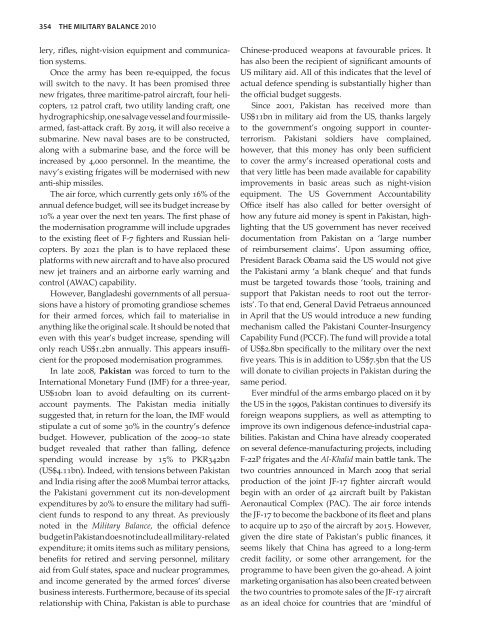You also want an ePaper? Increase the reach of your titles
YUMPU automatically turns print PDFs into web optimized ePapers that Google loves.
354 The MiliTAry BAlAnCe 2010<br />
lery, rifles, night-vision equipment and communication<br />
systems.<br />
Once the army has been re-equipped, the focus<br />
will switch to the navy. It has been promised three<br />
new frigates, three maritime-patrol aircraft, four helicopters,<br />
12 patrol craft, two utility landing craft, one<br />
hydrographic ship, one salvage vessel and four missilearmed,<br />
fast-attack craft. By 2019, it will also receive a<br />
submarine. New naval bases are to be constructed,<br />
along with a submarine base, and the force will be<br />
increased by 4,000 personnel. In the meantime, the<br />
navy’s existing frigates will be modernised with new<br />
anti-ship missiles.<br />
The air force, which currently gets only 16% of the<br />
annual defence budget, will see its budget increase by<br />
10% a year over the next ten years. The first phase of<br />
the modernisation programme will include upgrades<br />
to the existing fleet of F-7 fighters and Russian helicopters.<br />
By 2021 the plan is to have replaced these<br />
platforms with new aircraft and to have also procured<br />
new jet trainers and an airborne early warning and<br />
control (AWAC) capability.<br />
However, Bangladeshi governments of all persuasions<br />
have a history of promoting grandiose schemes<br />
for their armed forces, which fail to materialise in<br />
anything like the original scale. It should be noted that<br />
even with this year’s budget increase, spending will<br />
only reach US$1.2bn annually. This appears insufficient<br />
for the proposed modernisation programmes.<br />
In late 2008, Pakistan was forced to turn to the<br />
International Monetary Fund (IMF) for a three-year,<br />
US$10bn loan to avoid defaulting on its currentaccount<br />
payments. The Pakistan media initially<br />
suggested that, in return for the loan, the IMF would<br />
stipulate a cut of some 30% in the country’s defence<br />
budget. However, publication of the 2009–10 state<br />
budget revealed that rather than falling, defence<br />
spending would increase by 15% to PKR342bn<br />
(US$4.11bn). Indeed, with tensions between Pakistan<br />
and India rising after the 2008 Mumbai terror attacks,<br />
the Pakistani government cut its non-development<br />
expenditures by 20% to ensure the military had sufficient<br />
funds to respond to any threat. As previously<br />
noted in the Military Balance, the official defence<br />
budget in Pakistan does not include all military-related<br />
expenditure; it omits items such as military pensions,<br />
benefits for retired and serving personnel, military<br />
aid from Gulf states, space and nuclear programmes,<br />
and income generated by the armed forces’ diverse<br />
business interests. Furthermore, because of its special<br />
relationship with China, Pakistan is able to purchase<br />
Chinese-produced weapons at favourable prices. It<br />
has also been the recipient of significant amounts of<br />
US military aid. All of this indicates that the level of<br />
actual defence spending is substantially higher than<br />
the official budget suggests.<br />
Since 2001, Pakistan has received more than<br />
US$11bn in military aid from the US, thanks largely<br />
to the government’s ongoing support in counterterrorism.<br />
Pakistani soldiers have complained,<br />
however, that this money has only been sufficient<br />
to cover the army’s increased operational costs and<br />
that very little has been made available for capability<br />
improvements in basic areas such as night-vision<br />
equipment. The US Government Accountability<br />
Office itself has also called for better oversight of<br />
how any future aid money is spent in Pakistan, highlighting<br />
that the US government has never received<br />
documentation from Pakistan on a ‘large number<br />
of reimbursement claims’. Upon assuming office,<br />
President Barack Obama said the US would not give<br />
the Pakistani army ‘a blank cheque’ and that funds<br />
must be targeted towards those ‘tools, training and<br />
support that Pakistan needs to root out the terrorists’.<br />
To that end, General David Petraeus announced<br />
in April that the US would introduce a new funding<br />
mechanism called the Pakistani Counter-Insurgency<br />
Capability Fund (PCCF). The fund will provide a total<br />
of US$2.8bn specifically to the military over the next<br />
five years. This is in addition to US$7.5bn that the US<br />
will donate to civilian projects in Pakistan during the<br />
same period.<br />
Ever mindful of the arms embargo placed on it by<br />
the US in the 1990s, Pakistan continues to diversify its<br />
foreign weapons suppliers, as well as attempting to<br />
improve its own indigenous defence-industrial capabilities.<br />
Pakistan and China have already cooperated<br />
on several defence-manufacturing projects, including<br />
F-22P frigates and the Al-Khalid main battle tank. The<br />
two countries announced in March 2009 that serial<br />
production of the joint JF-17 fighter aircraft would<br />
begin with an order of 42 aircraft built by Pakistan<br />
Aeronautical Complex (PAC). The air force intends<br />
the JF-17 to become the backbone of its fleet and plans<br />
to acquire up to 250 of the aircraft by 2015. However,<br />
given the dire state of Pakistan’s public finances, it<br />
seems likely that China has agreed to a long-term<br />
credit facility, or some other arrangement, for the<br />
programme to have been given the go-ahead. A joint<br />
marketing organisation has also been created between<br />
the two countries to promote sales of the JF-17 aircraft<br />
as an ideal choice for countries that are ‘mindful of


